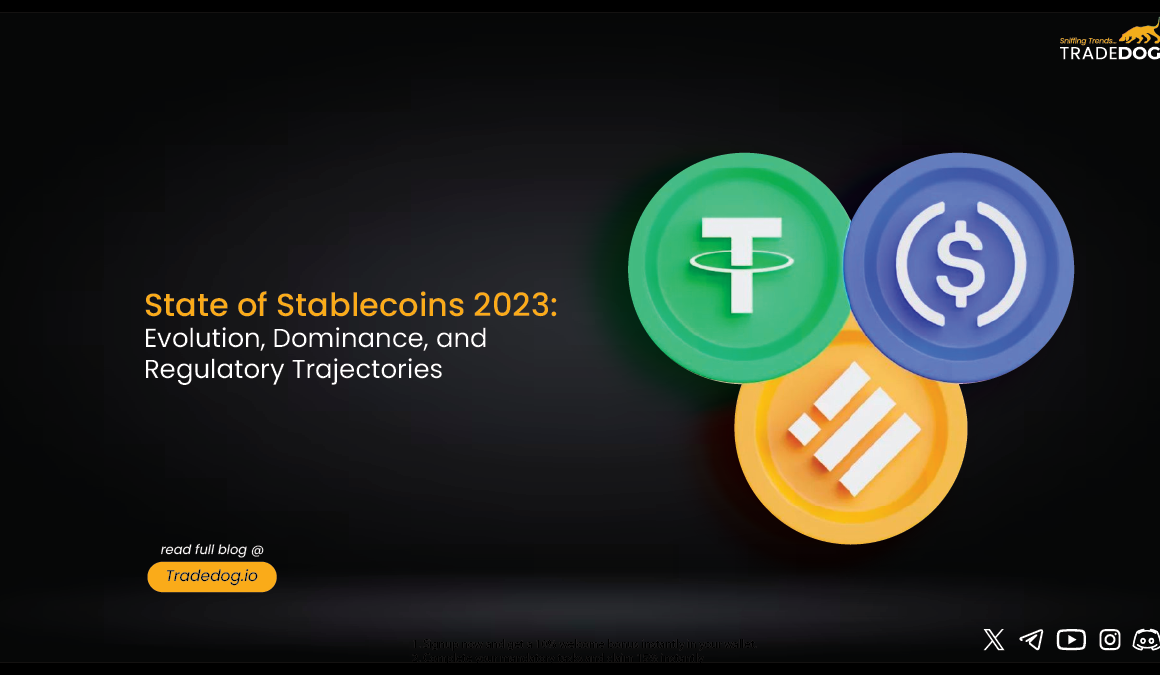Stablecoins, a cornerstone in the cryptocurrency ecosystem’s rapid evolution, played a pivotal role across sectors such as trading, lending, and asset management. With a market capitalization exceeding $129 billion, they accounted for 8.7% of the total cryptocurrency market capitalization, at the date of writing.
Market Overview
In 2023, centralized and fiat-backed stablecoins dominated the market while newcomers like crvUSD and GHO spurred competition and innovation. However, interest in algorithmic stablecoins declined as countries, including the UK, focused mainly on regulating fiat-backed options. For instance, Frax Finance’s community vote in Feb ’23 led to a complete collateralization of FRX, eliminating its algorithmic nature, supported by a 98% voter majority opting for a 100% collateral ratio.
- Market Capitalization
Following USDC’s de-peg, investors opted for USDT over USDC that resulted in Tether’s dominance soaring from 47% in Nov ’22 to 71% in Nov ’23 and it reached a market cap of over $88 billion.
Post-SVB’s collapse, USDC’s market cap nearly halved, depegging to below 85 cents around March 2023. This depegging also affected DAI since it is heavily reliant on USDC reserves, and it dropped to $0.85. However, both stabilized after the Federal Reserve reassured bank support, returning to their peg levels.
- USDT Reserves Component
Tether diversified its deposits across multiple banks increasing their US Treasury bills reserve to 76.44% of Cash & Cash Equivalents (as reported in the audited report by BDO) during the year. This measure might have ignited trust within the USDT token holders which is replicated with a surge in its dominance.
Trends
- The adoption of stablecoins by banks and fintech firms gained significant traction, signifying a notable shift in the traditional financial sector. For instance, PayPal launched PYUSD, its stablecoin pegged to the US dollar, NAB Bank achieved a pioneering intra-bank cross-border transaction using its stablecoin on the public Ethereum blockchain.
- The migration of stablecoins to Layer 2 solutions emerged as a standout trend in 2023, with over $1.87 billion on Arbitrum, $569 million on Optimism, and $102 million on zkSync.
- New categories of stablecoins:
- Collateralized debt position (CDP) stablecoins – It refers to loan agreements based on smart contracts whereby users deposit assets (e.g. ETH) as collateral and receive a stablecoin-denominated loan in return Recent launches include crvUSD by Curve Finance and GHO by Aave.
- Stablecoins backed by liquid staking tokens (LSTs) – They are overcollateralized by liquid staking tokens and employ the same model as CDPs. For instance, Prisma’s mkUSD and Lybra’s eUSD.
Regulatory Updates
- MiCA Regulation: These regulations targeting stablecoins will take effect in Europe starting June 30, 2024. Under MiCA, stablecoin issuers must maintain 1:1 reserves, ensuring full coverage for claims and redemption rights. EU exchanges are mandated to delist stablecoins from issuers lacking EU EMI licenses.
- Singapore Stablecoin Legislation: In August ’23, the Monetary Authority of Singapore unveiled a regulatory framework for single-currency stablecoins, linked to the Singapore dollar and G10 currencies under which issuers will be mandated to maintain ample reserves, ensure liquidity for redemptions, and comply with disclosure standards.
- United Kingdom Stablecoin Legislation: In 2024, the UK plans to regulate fiat-backed stablecoins through the FCA within payment systems. Non-fiat-backed or algorithmic variants won’t fall under regulated payment chains, similar to unbacked crypto assets. Overseas stablecoins must meet UK standards, and the FCA would have the authority to enforce reserve holdings in a statutory trust, following the Financial Services and Markets Act.
Future Outlook
Dollar-based stablecoins like USDC and USDT, with a combined market cap over $100 million, will continue to dominate due to the US dollar’s global FX market influence and users’ preference in inflation-hit countries, despite the rise of alternatives like cEUR and cREAL.
The future of stablecoins seems entwined with regulatory scrutiny. Governments are likely to introduce stricter regulations mandating proper reserves auditing for stablecoin issuers in 2024 to fortify stability and safety of the investors’ interest.
Innovative stablecoin designs like stablecoins backed by diversified asset baskets rather than singular fiat currencies could also be a major trend as it enhances stability and provides resilience against market fluctuations.
Lastly, institutions increasingly embracing stablecoins for various applications may serve to validate and propel the institutional adoption of stablecoins and such a trend could lead to more robust integration into financial systems.
Crypto Outlook 2024
2023 was a roller-coaster ride for the crypto sphere, marked by dynamic shifts, innovative advancements, and transformative trends that reshaped the industry’s landscape. Our Crypto Outlook Report for 2024 reflects on the highs, lows, and pivotal moments that defined the past year, while also peering into the horizon to forecast the exciting potential and emerging patterns set to influence the year ahead, with insights from industry leaders at Stepn, Enjin, Hacken, SuperScrypt, and more.
Click here to read the full report!









